A Hymn to Lee Bay
Share this page

North Devon has a plethora of beautiful corners, but I have a particular soft spot for Lee Bay. There are few places on the south west coast that are as low key. Perhaps it is because there is no sand on its shore that people flock instead to nearby Woolacombe. On a sunny Sunday like this, the road to Woolacombe is busy all morning, the car parks and roadsides filling up with cars and vans disgorging children, surfboards and picnics. The road to Lee on the other hand is a tiny lane that winds down through the trees and cottages to a small free car park near the front. It has been severed in two by works that threaten to reshape the tiny hamlet, so it is a particular chaos of mud and reversing vehicles today. The hotel that dominates the short Lee seafront has been closed for some time, but the crumbling edifice is now being pulled down, half of the structure remaining alongside a morass of mud and debris. This will soon be apartments and the bottom end of the hamlet will feel very different next time I visit. I am sad to see it go – somehow the faded grandeur of the hotel seemed perfectly fitting for this place.
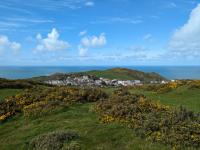
My run takes me up the verdant Borough Valley, following the crystal clear stream that runs through the heart of the hamlet and rushes noisily across the rocky shore to the sea. After a steep climb out of the woods, I cross the bright green fields past Damage Barton (a great name for a farm!) and Easewell Farm, before clambering onto the rocky heights above Mortehoe. Devonian slate outcrops poke from the gorse-covered ground and it reminds me of nearing the coast in parts of Wales, with which of course it shares a geological link. Mortehoe lies in a hollow below, marked by churches with both spire and tower, exciting for Ordnance Survey fans, while the sweep of Woolacombe Bay glistens in the sun to the south. The wind chills me as I drop down to the rocky shore to head out to Morte Point, a barren headland composed of sharp slate fins that slide shallowly into the sea. On my last visit, it was grey and misty and this place seemed wild and untamed, but in the sun today it is hard not to feel a more benign presence.
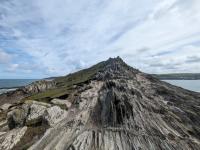
I turn east and, with the wind at my back, follow the coast path on its rise and fall around Rockham Bay, where the steps to the beach have collapsed and the sand is now left to the seals. On past the lighthouse on Bull Point, more climbing before the steep drop into Bennetts Mouth and Hilly Mouth. It is exhilarating running, if hard work, and I am very sweaty by the time I reach the steps down to Sandy Cove. They drop precipitously down to a secluded beach that is misnamed but absolutely exquisite. Small, flat slate pebbles form a grey beach that angles into turquoise waters, sheltered between rocky outcrops. I want to run straight into the sea, but kick off my shoes and drop my top on the beach before plunging into the Atlantic waters. I want to lie back and soak in the sun, savour this moment of paradise, but the cold water makes my breath short and all I can manage is a minute of frantic swimming before I have to get out. There are only a few others on the beach, kids splashing around in wetsuits and parents quaffing tinnies of cider. This is my sort of beach.
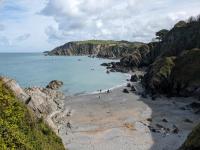

The England Coast Path - Book 2: The South West Coast
£15.99A practical guidebook for walking over 650 miles of the England Coast Path from the River Exe to the River Severn. Starting in Exmouth and finishing in Chepstow, this book covers the coasts of Devon, Cornwall, Somerset & Avon.
Buy Now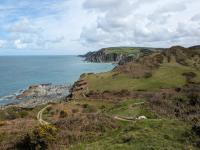
Lee Bay is just round the corner, but there is little chance to swim there. The rocky shore is a line of slate ribs running out to sea, separated by heaps of seaweed. The sedimentary layers are almost vertical on this part of the coast and hunks of rock break the bay into several coves. For half of the tide you can wander over the various ridges to explore these. The rock is surprisingly smooth given how many fine layers of rock it bares, and the shapes of its formations are sublime. High above, the rock layers fold over as if to enclose the land below and I am left in awe of its geology. But you can’t admire the rocks for too long as the insistent waves soon lap at your feet and remind you that you’ll soon be cut off. The Bristol Channel’s great tidal range means it creeps upon you rapidly here and you soon have to tiptoe round a rock shelf to return to safety.
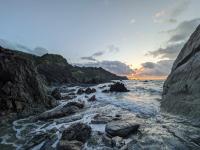
The sun always sets across the jagged rocks of the western headland and paints beautiful colours across the bay, whatever the state of the tide. I look up at the pine trees that stand on the slopes above either side of the bay, and decide that the lone tree on the crest above my cove is particularly special. Bowed with the wind, it arcs over like an F, but cuts a fine outline against the deepening blue sky – when it’s dark it gives the bay a sense of being in a tropical paradise. We don’t know enough individual trees, notice one over another, treat them as specific characters not en masse, so it is nice to be able to reacquaint myself with a tree I have known before.
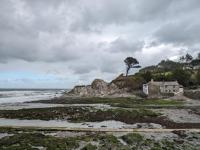
Dusk means it is time for the pub. I walk the path from the car park past the toilet block, the sort of traditional public toilet that there are few of left. It is open all hours, there is a proper tap rather than a dispensing machine, and rolls of loo roll make it feel as homely as a dunny can. The path leads through the few flat fields here between the steep wooded slopes that hem the valley in, while birds fill the evening’s speakers. Emerging in the heart of Lee hamlet by the Grampus Inn, I am reminded by the sign that the grampus is a type of dolphin that are occasionally seen around the Devon coast. I love the pub’s quiet entrance, barely noticeable round the back of its tiny car park. There is a picturesque garden I have sat in before, but I head into the warm slate bar beneath low wooden beams. However, there is a reason it is so downtempo – it is closed on a Sunday evening. My disappointed face must speak a thousand words as, after a few moments, one of the group sitting to eat at a large table in the main room offers to get me a drink. I pay with cash for a local pint of Hoppy Dog ale, sitting to write while a group of young people from all over the world talk about their travels and plans. I am jealous of their boundless spirit – this is all new to them, they are not returning to Lee Bay to rekindle moments of the past, they are making them anew. Soon I am drunk enough not to care and wander back through the night, the clear moon above drawing the water in and out of this tranquil bay while stars fill the tropical sky.
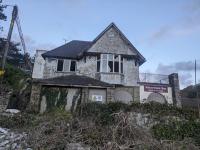
The England Coast Path - Book 1: The South Coast
£15.99A practical guidebook for walking over 700 miles of the England Coast Path from the River Thames to the River Exe. Starting in Woolwich and finishing in Exmouth, this book covers the coasts of Kent, Sussex, Hampshire, the Isle of Wight and Dorset.
The England Coast Path - Book 2: The South West Coast
£15.99A practical guidebook for walking over 650 miles of the England Coast Path from the River Exe to the River Severn. Starting in Exmouth and finishing in Chepstow, this book covers the coasts of Devon, Cornwall, Somerset & Avon.

